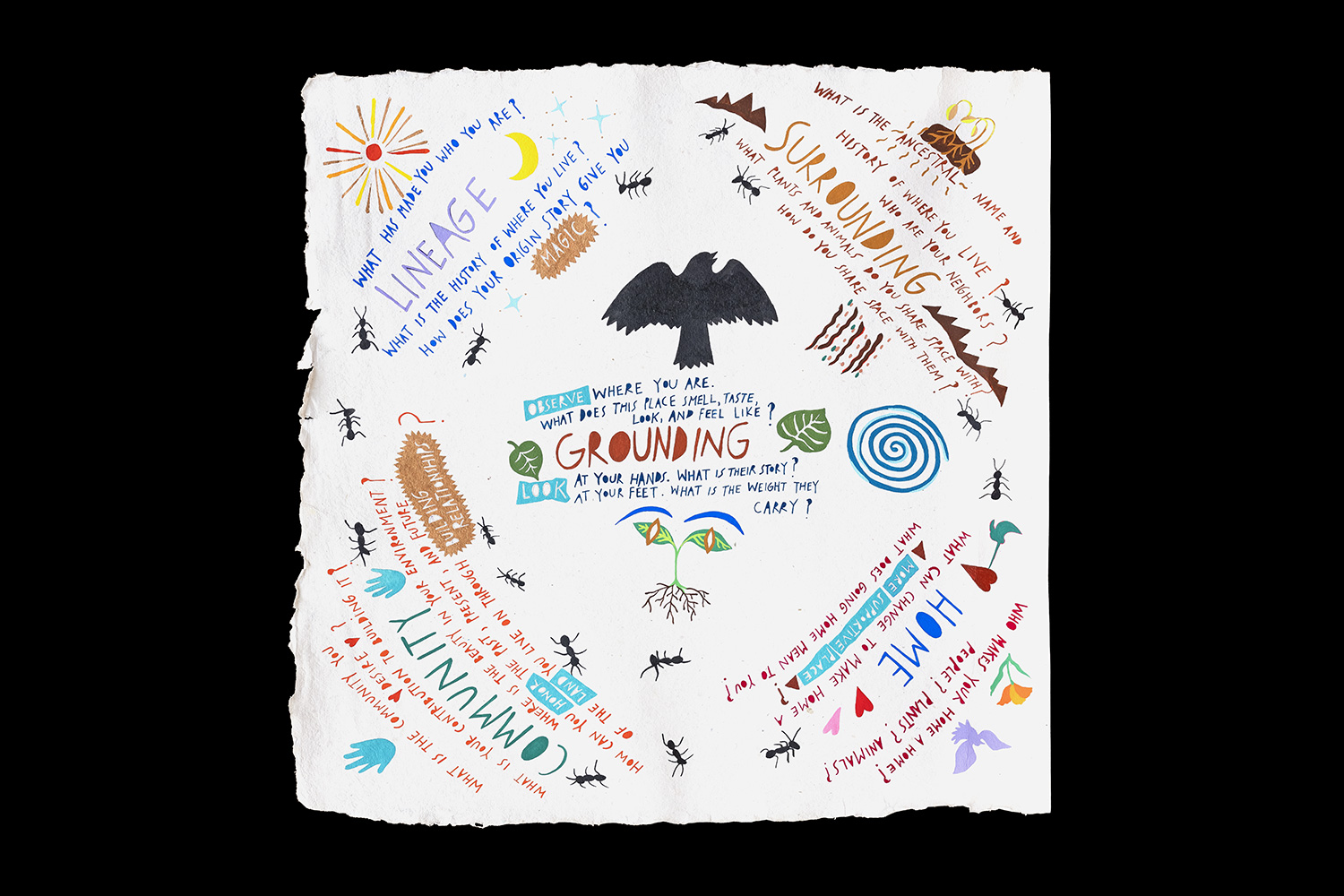An Offering
to Unsettle
Settlement
“How does one make sense of their own participation in the world, taking into consideration pasts that have formed legacies of colonialism and disenfranchisement? This question, considered through a philosophy of addressing and repairing harm, has led us to center Indigenous and land-based environmental stewardship and climate change mitigation in our collaboration. Drawing from our studio practices, we developed An Offering to Unsettle Settlement to ask participants to reflect on their stories, climate, and futures while grounding them in the intimacy of their immediate environments.”
veronique d'entremont, Joel Garcia, iris yirei hu

The five principles
This project is broken down into five principles that have guided our process in creating this offering. Each principle invites you to reflect on three questions.
We invite you to use these questions as a writing or conversation prompt, or sit with them before you begin. You can respond to these questions. You can draw these questions. You can make new questions.
Through this project, we have suggested tools and approaches for thinking and making including a guided listening exercise, and a printmaking exercise through which you will make an accordion style booklet using plants and organic materials to create dyed images, also called an ecoprint (instructions enclosed).
This process is meant to be a starting point for deepening your own reflective practice.
Grounding
Observe where you are.
What does this place smell, taste, look and feel like?
Look at your hands. What is their story?
Look at your feet. What is the weight they carry?
Lineage
What has made you who you are?
What is the history of where you live?
How does your origin story give you magic?
Surrounding
What is the ancestral name and history of where you live?
Who are your neighbors?
What plants and animals do you share space with?
How do you share space with them?
Home
Who makes your home a home? People? Plants? Animals?
What can change to make home a more supportive place?
What does going home mean to you?
Community
What is the community you desire?
What is your contribution to building it?
Where is the beauty in your environment?
How can you honor the past, present and future of the land you live on through building relationships?
Suggested steps
1
Respond to the five guiding principles stated above. This may be in any form: a conversation, personal writing, whatever feels most appropriate.
2
Experience audio work A Practice of Becoming Lost.This piece will guide you through a walk in your neighborhood, including suggestions to collect materials used in step three. You can download the printed poem here.
3
Using the materials collected on your walk, use ecoprint techniques to make a book reflecting on this process. Please see instructions below for how to make a simple accordion booklet and an ecoprint.
4
Share a photo of your experience by tagging #AnOfferingToUnsettleSettlement.
5
Join us on Saturday June 5, 10AM-12PM for a remote reflection session. This will be an opportunity for you, our participants-turned-collaborators to hear more about our process in developing these prompts, ask questions, and share discoveries you have made while engaging with this work.
Accordian booklet instructions

1
You’ll need a long sheet of cotton rag paper. It's important that the paper is cotton based such as watercolor paper.
2
Cut the sheet down the middle so you end up with two long strips.
3
You will need to fold the paper into 7 sections (panels). Below are some measurements for available paper sizes at art and office supply stores. Fold the first panel to the sample size below. Flip the edge of the paper back to meet the fold, and crease, and repeat.
18 x 24 in sheet, cut down to (2) sheets of 9 x 24 in. Folds to 9 x 3.4 in. Panel width 3.4 in.
12 x 18 in sheet, cut down to (2) sheets of 6 x 18 in. Folds to 6 x 2.5 in. Panel width 2.5 in.
9 x 12 in sheet, cut down to (2) sheets of 4.5 x 12 in. Folds to 4.5 x 1.7 in. Panel width 1.7 in.

Eco Booklet Instructions
After responding to the invitation to walk in your neighborhood, create an accordion booklet. Use the materials you collected to make an ecoprint according to the below instructions.
Review and prepare necessary tools and instructions before beginning.
Tools needed:
— Accordion booklet
— 1 tsp Aluminum Sulfate
— Large pot or old plastic container
— Water
— Plants collected on your walk
— Twine (provided)
— Cardboard (2 x pieces the same size as your booklet)
— Large pot with lid
— Bath towel
— Drawing (or embroidery) materials
Step 1
Mordant (Condition) the paper
Tools: 1 tsp Aluminum Sulfate / Large Pot or old plastic container filled with 2 gallons of water / Accordion Booklet
Dissolve (1) teaspoon of aluminum sulfate in a cup of hot water, then add it to (2) gallons of cool water
Place booklet in the water. Let it set for 2-3 hours.
Step 2
Prepare Booklet & Plant Bundle
Tools: Plants you collected / Booklet (still damp) / Twine / Cardboard (2 x 6 inch square pieces)
Layer the plants and materials you collected between the folds of the accordion booklet. You will have a total of 6 layers of materials between the folds of paper. Only use flat items.
Place one piece of cardboard on each end of the booklet. Press together and wrap tightly with the twine, leaving 6-8 inches of twine loose. Make sure the twine does not come loose.
Step 3
Steaming
Tools: Large Pot / Booklet
Add water to the pot about 1 finger deep.
Tie your booklet to one of the pot handles using the 6-8 inch piece of twine you left loose. Lower the tied booklet into the pot, making sure it does not touch the water.
Place the pot on the stove on medium to low until the water is simmering.
Place a lid over the pot to keep the steam in. Leave for about two (2) hours. Make sure to check the water level regularly so it doesn’t run dry. Add more water as needed.
Step 4
Ecoprint Reveal
Tools: Bath towel
Turn off the stove, being careful with the hot steam and pot.
Carefully remove the booklet from the pot.
Remove the twine.
Remove leaves and materials from booklet.
Set your booklet out to dry on a bath towel.
Step 5
Rerooting
Tools: Drawing (or embroidery) materials
Once your booklet is dry, select the side your prefer. Locate the center panel. You will have three panels to each side of the center.
Review the principles on the bandana provided, and reflect on these prompts.
Draw in the center panel something that best represents how you connect to the place you reside in. Heavily consider the principles of Grounding and Home.
On the panels to the left, reflect on the principles of Lineage and Community, and the efforts your three (3) previous generations endured for you to find yourself in the city/town you reside in. Draw in one (1) panel for each generation.
On the panels to the right, reflect on the principles of Home and Surrounding. Draw in what you imagine you can commit to, to help your next three (3) generations be the best guest on the homelands of the Tongva, Tataviam and Chumash communities, Los Angeles.
Consider reading Our Sacred Waters: Theorizing Kuuyam as a Decolonial Possibility by Charles Sepulveda (Tongva/Acjachemen).
